 A freshly transplanted Black pine. The photo is from our Masters’ Series Pine book.
A freshly transplanted Black pine. The photo is from our Masters’ Series Pine book.
Three’s a charm
Much of what follows originally appeared in 2010 and much of that reappeared in 2012. Normally that would be enough, but because this one is so seasonally pertinent and because we have so many new readers, it’s worth at least one more shot. It’s also worth mentioning that we’ve added some new text and done some editing.
Fall transplanting
It’s the beginning of fall transplanting season here in the north country. One advantage to transplanting in the early fall is that when the spring season starts, little or no top-growth time is lost. The reason this works is that roots experience strong growth in the fall while the soil is still warm, long after the top has shut down. So by the time the tree wakes up in the spring, the roots are either fully recovered or well on their way to full recovery.
There’s one caveat however; in cold weather climates, very heavy root pruning is best saved for the spring. If cold weather sets in too soon before the roots have recovered, winter survival can be threatened. Better stick to light to moderate root pruning in the fall if you live where the winters are very cold.
Don’t wait too long however
Because our summer to fall to winter changes can happens quickly here in northern Vermont, timing is essential. In the past I’ve had the best results (mostly with larches) from the last few days of August to the around the 10th of September. For reference, our first hard frost can happen any time from mid-September to early October though there’s almost always some mild weather after our first hard frost. This mild weather, which often lasts into early November, keeps the soil warm enough for roots to grow and recover.
Top pruning in the fall
It can be a good idea to top prune a little when you transplant, especially if the roots have been severely disturbed (less foliage for the compromised roots to support). However, too much top pruning when transplanting, especially in the fall, can stress a tree. Beyond that, I am still experimenting with the right mix of root-versus-top pruning on my larches, and the jury is still out on just how much I can get away with. In general, much depends on variables like the type tree, where you live, when in fall you transplant, what transplanting aids you use, aftercare, etc.
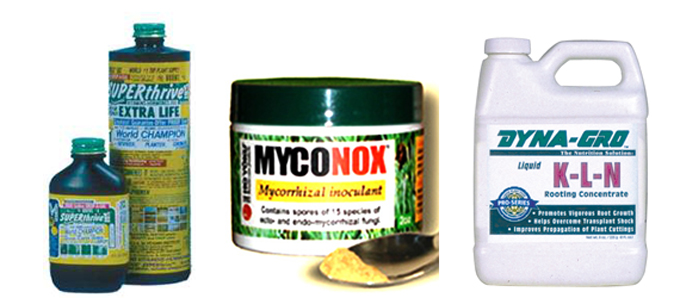 Daddy’s little helpers. These three items are indispensable when it comes to transplanting. Surperthrive is a vitamin and hormone plant tonic, Myconox helps replace the all-important mycorrhizal fungi, and Dyna-Gro K-L-N is a rooting compound that is formulated to reduce stress and encourage growth.
Daddy’s little helpers. These three items are indispensable when it comes to transplanting. Surperthrive is a vitamin and hormone plant tonic, Myconox helps replace the all-important mycorrhizal fungi, and Dyna-Gro K-L-N is a rooting compound that is formulated to reduce stress and encourage growth.
Recycling
The photos and text from here down are from an 2010 Bonsai Bark post titled Transplanting Tips: An Uncommon Technique.
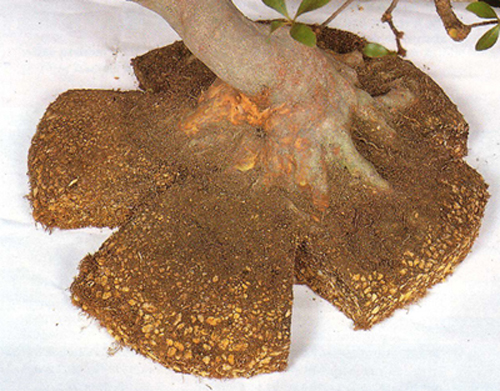 Pieces of the pie. From Bonsai Today issue 39.
Pieces of the pie. From Bonsai Today issue 39.
Keeping some roots undisturbed
The technique shown here is particularly good if you want to replenish the soil while leaving some of the roots undisturbed. Doing this lessens stress and hastens recovery.
Pot sizes and shapes
This technique is useful when you want to move a tree from a larger to a smaller pot, or into a pot that has a different shape. It also works when you want to replenish some of the soil and then put the tree back into the same pot and is particularly useful for repotting forest plantings.
Potbound trees
If the roots aren’t well enough established to hold the soil together when you take the tree out of the pot, then this technique won’t work. Ergo, this technique is particularly good when dealing with potbound trees.
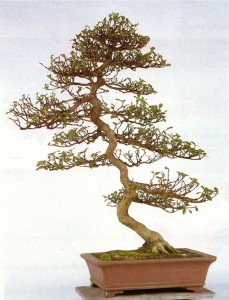 Before. A well developed Satsuki azalea in the wrong pot.
Before. A well developed Satsuki azalea in the wrong pot.
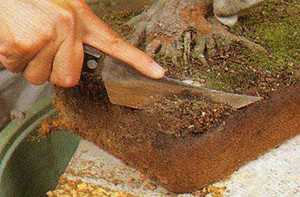 Cutting corners. Because you’re going from a rectangular pot to a round pot, you start by cutting off the corners.
Cutting corners. Because you’re going from a rectangular pot to a round pot, you start by cutting off the corners.
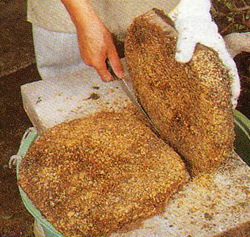 Removing the bottom roots. In almost all cases, you want to remove the lower roots. This encourages roots to spread out rather than grow down; because the tree mirrors the roots, it encourage the above ground growth to spread, which is want you usually want with bonsai. Another reason to remove the bottom roots is to make more space to replenish the soil.
Removing the bottom roots. In almost all cases, you want to remove the lower roots. This encourages roots to spread out rather than grow down; because the tree mirrors the roots, it encourage the above ground growth to spread, which is want you usually want with bonsai. Another reason to remove the bottom roots is to make more space to replenish the soil.
Want more?
Here’s the original post in its entirety.
Does anybody really know what is in the compnents of Superthrive?
I use Superthrive on all my newly transplanted and repotted trees. It really seems to help root growth.
B vitamins make up a large portion of its formula, the rest remains a closely guarded secret of garden gnomes who live in the enchanted forest. I swear by the stuff.
I’m not getting near this one ;-)
Yeah, a curvy azalea in a rectangular pot . What were they thinking?
Superthrive also contains rooting hormones. I have used it in pinch to treat cuttings. Be advised: the B vitamin can be attractive to cats, so keep it put away. The meatl cap tends to corrode, so I replace it with a plastic one.
Hi Terry,
Nick Lenz cautions against using too much Superthrive, at least on larches, in his Bonsai from the Wild .
-w